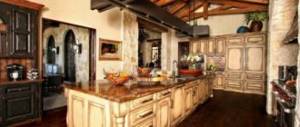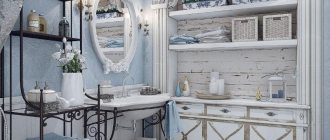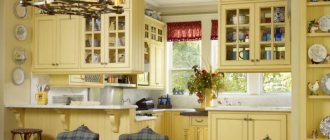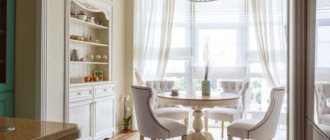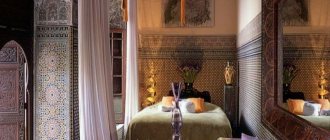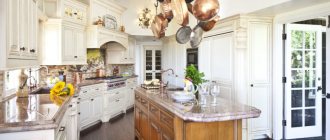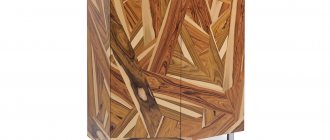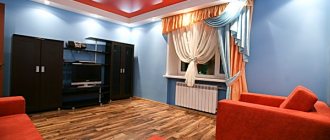Moroccan motifs
In the article “Interior in African style” we talked about the features and main features of the so-called “pan-African style”. The interior style typical of one of the African countries is of great interest. We are talking about Morocco. Moroccan interior style is usually distinguished from the general African style. The interior style of Moroccan homes is bright and original, because two cultures are harmoniously intertwined in it: African and Arab.
In addition, the influence of Roman, Greek, Spanish, and Muslim cultures was felt. This mixture makes Moroccan interiors unusually colorful and attractive. The interior in the Moroccan style is compared to Arab beauties - sultry, alluring and mysterious.
Interior in Moroccan style: colors
The Moroccan interior contains colors characteristic of the African style, that is, the colors of the nature of the black continent: desert, scorching sun, shady jungle, fires in the African night. These are sand, orange, terracotta, red (various warm shades of red), brown, swamp green, etc.
However, in addition to this, Moroccan interiors use colors characteristic of the Arabic style: pink-orange, gold, scarlet, fuchsia, royal blue, dark purple, burgundy, etc.
Moroccan interiors are also influenced by Asia, so they feature a lot of white. Sometimes white color is present in the decoration of both walls and floors at the same time. Dark furniture and bright textiles on a white background create a contrast typical of African design.
This mixture underlies the polychrome (multicolor) characteristic of Moroccan interiors. Another color feature of Moroccan-style interiors is the use of various shades of blue (natural, associated with the color of the sky) for finishing floors, walls, and ceilings.
Style is in the details
It is the details that make the Moroccan style so recognizable and unusual. Each of which brings a touch of sophistication and uniqueness.
In Morocco, thick blackout curtains serve as protection from the scorching sun, creating twilight and coolness in the room.
Glazed ceramic tiles also serve as a means of protection against the sweltering heat in the country where this style originated. In our interior it will become just another bright accent.
Particular attention is paid to forged products. These can be pieces of furniture, lamps or chandeliers. Each of these details is either made by hand or very similar to what ancient craftsmen would have made, which will add mystery to the room.
Oriental arches and stucco in their form are also a distinctive feature of this style, making it even more refined and original.
When creating a Moroccan-style interior, don't be afraid to fill it with colorful handmade items, be it furniture or pillows.
After all, it is precisely such details that allow you to feel all the luxury of the East. Tags:
Moroccan style in the interior: decoration
Floors. Most often, stone floors are found in Moroccan interiors , due to climatic conditions. The stone is cold, but on hot days and sultry nights the coolness of the floor increases the level of comfort.
If the coldness of a stone floor scares you, you can choose a tile or wood laminate. In Moroccan interiors, wooden floors are also not uncommon: mostly rough boards and stacked parquet (wooden modules of different colors are laid out in a certain way to create a beautiful ornament). But if we are talking about styling, laminate .
However, the optimal solution for the floor in a Moroccan interior is still warm-colored porcelain tiles (brown, terracotta, beige). The size of the tile can be different: large, medium and very small (mosaic).
Additional decorative tiles and mosaics are used to create a floor pattern. The tiles themselves, laid on the floor, are most often not monochromatic, but with ornaments.
There must be carpets on the floors in the living room and bedrooms. You can, of course, lay a carpet with an ornament, but it is better to lay a stone or wooden covering on the floor and decorate it with a small Arabic-style carpet.
Walls. In living rooms and hallways, the walls are most often plastered. In Morocco, decorative textured plaster is used to decorate walls, after application of which the walls become like marble. Plaster can be ordinary. Then the plastered walls are painted with colored or snow-white paint.
In wet rooms and front halls, the walls are decorated with bright mosaics that form a Moroccan pattern .
Bathroom element in a Moroccan-style home
In the foyer and living rooms, the walls are decorated with ornamental paintings in the Moroccan style .
Wall decor in a Moroccan interior
Ceiling. The ceilings in Moroccan houses are very high. They are painted in one of the commonly used colors. Traditionally, in common rooms the ceiling is blue or blue - it symbolizes the sky. A border is made between the wall and the ceiling - it can be a mosaic, painting or lace stucco.
In expensive Moroccan interiors, the ceilings can be wooden - carved or painted with Moroccan ornaments. The work is difficult and very expensive, but the result is amazing.
In poor houses, branches and twigs (eucalyptus, oleander) were laid across the beams. Often they were covered with lime mortar, less often they were left in their original form. Such ceilings are also created in our time to introduce ethnic features into the interior.
What else distinguishes a Moroccan-style interior? Firstly, there are numerous niches in the walls. Lamps or candelabra with candles, as well as books, engravings and other decorative items are installed in the niches. The niches are either arched or pointed , although they can also be rectangular.
Some of the niches can be covered with patterned forged grilles (you will get a kind of false windows). However, metal grilles can become an independent wall decor in a Moroccan interior - you just need to hang them on the wall.
Other openings in the walls—windows and doors—are also arched and lancet. The doors are patterned, decorated with carvings and stained glass.
The inside of the windows can be decorated with carved wooden shutters and forged grilles.
In a Moroccan- style interior, there should be few right angles. The favorite shape is the one that resembles a keyhole.
Exoticism versus originality: Colonial and Moroccan interior styles
In interiors in Colonial and Moroccan styles, the ethnic theme dominates. What is the difference between exotic and original in interior design and what do you need to know to distinguish between these styles?
| Options | Colonial style | Moroccan style |
| Wall decoration |
|
|
| Ceiling finishing |
|
|
| Floor finishing |
|
|
| Materials | Natural:
| Natural:
|
| Color spectrum | Warm natural shades
| Combination of cold and warm tones
|
| Drawing |
|
|
| Furniture |
|
|
| Textile | Natural fabrics:
| Natural fabrics of bright rich colors:
|
| Lighting | Maximum light
| The light is diffused, muted, soft
|
| Items in the interior |
| All interior items are richly decorated: paintings, mosaic ornaments, colored glass, etc.
|
Colonial style: exotic, respectable and luxurious
The colonial style in the interior arose in the era of great geographical discoveries of the 17th century. The maritime powers of the Old World - Britain, Holland, Spain and France - captured new territories, establishing many colonies in different parts of the world. Finding themselves in a new environment, the colonists sought to preserve their traditions and way of life, introducing into it elements of the culture of the indigenous population. Colonial style in the interior is a mixture of East and West, the primordial traditions of settlers and exoticism, imperial luxury and original ethnic elements.
Characteristic features of the Colonial style:
- Eclecticism, a mixture of different ethnic styles in one interior;
- Finishing materials of matte textures, roughly processed, with antique imitation;
- Lots of open space, lots of light, natural colors;
- “Animal” theme in textiles and furniture;
- Bright accents and large details are used in interior decoration;
- Tropical theme: exotic flowers and plants, palm trees, bamboo stems.
The architectural elements of the Colonial style are due to the hot climate and proximity to nature: spacious rooms, high ceilings with natural wood beams, large windows, high doors. This style is not characterized by a clear zoning of space; all transitions are smoothed out as much as possible due to columns, ceilings with “differences,” multi-level floors, partitions and screens. Blinds were used in the decor of interior doors and cabinet doors.
The main materials for cladding a house are stone and wood: stone masonry on the facades, massive wooden door and window openings; stone or wooden floors. The houses had access to the garden directly from the kitchen, living room or bedroom.
When decorating interior walls in a colonial style, either rough plaster, painting, or plain wallpaper with the texture of natural fabric is used. Wooden panels are also used to decorate walls.
The colonial style has “absorbed” the traditions and cultures of different countries; masks of African shamans, Japanese screens and Indian furniture coexist quietly in it. Textiles play a special role in the Colonial interior; there are a number of requirements for its selection:
- Exclusively natural materials;
- Shades and colors are as natural as possible;
- Fabrics with patterns of oriental patterns and ornaments;
- Fabrics with images of exotic animals and birds;
- Exotic prints: zebra, giraffe, leopard, tiger;
For the Colonial style, exotic plants are required: tropical trees in tubs, vines, ferns, palm trees, bamboo stems, orchids, etc.
The “animal” theme in furniture is another characteristic feature of the style. The legs of tables, sofas, armchairs and chairs were made in the form of lion paws; chests of drawers, tables, chests resembled animals in outline. Solid animal figures were also used to decorate furniture: monkeys in tailcoats “carrying” a wardrobe, bronze turtles with chests on their shells, etc.
Collections of ceramic tiles for interiors in the Colonial style
- Mainzu Bolonia
- Vives Atalaya
- L'antic Colonial Brick
- Vallelunga Audax
- Porcelanosa Safari
Moroccan style: originality and loyalty to traditions
The formation of the Moroccan style was influenced by Arab, Mediterranean and African motifs.
Characteristic features of the Moroccan style:
- Bright colors and ornaments, abundance of decor,
- Mixing colors and textures of materials;
- Mosaic for decorating floors, stairs, walls;
- Ceramic tiles with bright Moroccan ornaments and patterns for wall decoration;
- Lancet-shaped windows, patterned forged grilles;
- The impression of some homemade interior items;
The bright originality of the Moroccan style is visible in finishing materials, architecture, and interior decoration.
Decoration Materials
Thus, for finishing walls in residential premises they use decorative textured plaster tadelakt, which is also known as Moroccan plaster. After applying it, the walls look like marble.
Moroccan tiles, also called zelij (ceramic glazed tiles with bright oriental patterns), are also used for wall decoration.
The walls and floors are decorated with bright mosaics, which are laid out in Moroccan patterns - geometric or floral.
The most common is a geometric pattern, which is characterized by the use of a circle, divided into equal sectors in a variety of ways. From these sectors, rectangles, squares and polygons are gradually lined up in one line. The geometric Moroccan ornament uses repeated repetition of the same element.
Floral ornament. Images of fancy flowers or leaves. They are used in the drawing both singly and at the same time have large sizes, and in large quantities, while they are small in size.
Ceiling finishing
Moroccan-style rooms are characterized by high ceilings. According to tradition, ceilings in public spaces are painted blue or light blue, which symbolizes the sky.
In rich houses, the ceilings were made of wood carved or painted with Moroccan patterns. In the houses of the poor, twigs and branches were laid across the supporting beams. They were then “coated” with lime mortar or left untreated.
Architectural nuances
The premises have almost no right angles, doorways are made in the shape of pointed arches, and the doors are decorated with stained glass windows, patterns, and carvings.
Lancet or arched window openings are decorated from the inside with forged grilles and carved wooden shutters.
The room has a large number of different wall niches in which lamps, paintings, books, and decorative elements are placed. Niches can be decorated with patterned forged gratings.
Interior items and textiles
All objects and details look as if they had just come from the hands of a craftsman; there is a certain handicraft in them. Roughly crafted furniture, pottery, forged lamps. Moreover, all items are decorated with paintings, mosaic elements, pieces of glass, carvings, reminding that the owners of the house honor their traditions and culture.
Moroccan interiors are characterized by an abundance of textiles in bright colors: embroidered floor and sofa pillows, bolsters, carpets, multi-layer curtains, voluminous draperies: canopies over the bed, thin chiffon tulle on the windows, bedspreads and capes.
Collections of ceramic tiles for interiors in Moroccan style
- Bayker Batik
- Gambarelli Stardust
Brief summary:
For interiors in the Colonial style, oriental and Asian elements are an exotic component against the backdrop of European traditions. The style is eclectic and allows you to fill the interior with ethnic decors and elements from different countries.
Moroccan style is built on North African architectural and artistic traditions. He gave the world Moroccan ornaments and Moroccan tiles. The style is original and self-sufficient.
materials, furniture
The furniture is predominantly wooden, decorated with carvings, inlays, gilding or covered with mother-of-pearl.
Wooden furniture is usually dark - it is distinguished by a rich dark brown or red-brown color. Light ivory furniture is less common. Lancet shapes are characteristic not only of architecture, but also of furniture.
A Moroccan interior is unthinkable without patterned forging - these include tables, banquettes, benches, and much more.
Open living room in a real Moroccan courtyard
The sofas and armchairs are not too bulky. The upholstery can be different: plain neutral, plain bright or with an ornament. Sofas with plush upholstery will be very welcome. Sofas almost always have a lot of pillows with embroidery and tassels. Pillow covers are plush or silk.
Moroccan motifs in the interior
It is difficult to imagine the interior of a Moroccan-style living room without a large number of soft seats: one or two large or several small sofas, armchairs, ottomans, couches, couches, etc. Lounge furniture (sofas, benches) can also be wooden, including lattice or carved, covered with soft mats.
A long, low stand will fit under the TV in the living room. And instead of traditional tables, cabinets, and chests of drawers, wooden chests with carvings and paintings are often placed.
The Moroccan bedroom is an Arabic chillout, only instead of low beds there is a relatively high bed, but not too wide. The head of the bed is often decorated with fabric draperies, and a “tent” is often erected over the bed itself.
The shape of a wooden headboard can also be pointed. Chests can be placed near the bed instead of bedside tables.
In Moroccan-style interiors, the tops of low wooden tables and the lids of cabinets and chests of drawers are often decorated with multi-colored mosaics. When creating a Moroccan interior in a modern apartment , you can update old pieces of furniture, giving them an African-Arabic gloss . To do this, it is enough to update the furniture, covering it, if necessary, with stain and varnish with a mother-of-pearl effect, replacing the fittings and covering the lid with mosaics. The end part of the tabletop or lid can be covered with leather or braid with an ornament, decorated with tassels in the corners.
Characteristic features of Moroccan style
The unique flavor of Moroccan style charges with positive emotions and good mood, mainly due to the combination of many warm and cold shades. As you know, Morocco is located in Africa, where the sun and endless expanses of deserts reign, so it is not surprising that the main colors in the interior are yellow, red, orange, gold and brown. Arab culture also contributed, so blue, turquoise, purple, pink and cyan colors are often used.
The central element in the living room is a large chandelier of an unusual shape, made in white and gold.
The black ceiling, decorated with mirror inserts in the shape of stars, creates a feeling of depth in the room.
The kitchen set, made of expensive wood, is decorated with beautiful carvings.
An aged bedside table sets the tone for the interior of the nursery, made in the Moroccan style.
The lilac color in the decoration of the walls and ceiling looks simply amazing in the interior of the bedroom.
An abundance of bright poufs and decorative pillows is characteristic of the Moroccan style.
The predominant white color refreshes the living room interior and visually expands the boundaries.
A pointed arch in the wall adds texture to the interior, and the white color creates a feeling of spaciousness.
Wooden beams and living plants create a unique and rather original interior.
A peach-colored canopy made of light translucent fabric creates the illusion of a tent.
The fireplace insert, made in the form of a pointed arch, looks very impressive and colorful.
Bar stools and lighting fixtures are not only functional, but also quite beautiful.
The burgundy color and glossy surface of the headboard create an unsurpassed bedroom interior.
The round ceiling lamp harmonizes with the streamlined lines of the furniture.
Warm sand shades and deep wood colors look very impressive and at the same time cozy.
Despite the colorfulness of the Moroccan style, white color is no less relevant, and in large quantities. Quite often, walls, floors and ceilings are finished in monochrome white, as are pieces of furniture. The use of several textures, arched structures and curly lines gives expressiveness to the interior.
The Moroccan style in the interior is characterized by a number of distinctive features, so it is quite difficult to confuse it with another style. So, the main characteristics include the following points, namely:
- Architectural elements in the form of pointed arches. With the help of figured arches, characteristic exclusively of oriental styles, all kinds of decorative niches in the walls, doorways and fireplaces are designed. Window openings are also quite often made in the form of arches, additionally decorated with elements of figured forging;
- Organic combination of many colors. As mentioned earlier, the Moroccan style can use several quite bright colors at the same time, without compromising the overall aesthetics of the interior. This is a kind of symbol of the influence of a large number of cultures, in particular, Moorish, Phoenician, Berber, Andalusian and many others;
- The presence of painting in an oriental manner and mosaics. The combination of various floral motifs and clear geometric lines is embodied in the form of spectacular mosaics and colorful hand-paintings used in the design of walls, ceiling surfaces and furniture. Windows and doors are decorated with colorful stained glass windows. Today it is not necessary to use hard and painstaking manual labor, since modern materials perfectly imitate oriental painting, but if you wish, you can hire a professional decorative artist;
- Use of textiles in large quantities. Window and bed textiles made from expensive fabrics are an integral part of the Moroccan-style interior. Moreover, these can be either light translucent tulles or dense materials with rich decorative finishing. Particular attention is drawn to the many decorative pillows and upholstery of upholstered furniture. The central place is occupied by the carpet, which not only shows the level of wealth of the owners of the house, but also tells a certain story;
- Original pieces of furniture and accessories. As a rule, pieces of furniture are made of natural wood, most often of a dark, rich color. The main decor is considered to be figured carving, which is distinguished by its special aesthetics and at the same time difficulty in execution. Colorful lamps, vases and dishes are no less important, so the role of accessories should never be underestimated.
Hacienda: Attic “Marrakech” (04/17/2011)
At first glance, it seems that rooms made in the Moroccan style are too saturated with furniture and excessive decor, but this is far from the case. The fact is that residents of eastern countries are quite practical people, although they appreciate the beauty of the world around them, so even an ordinary sofa can have additional storage space, and large cabinets are replaced with compact and original chests of drawers.
textiles, decor, accessories
Moroccan interiors are distinguished by the use of a large amount of textiles. Lots of sofa and floor pillows, bolsters. Walls and ceilings can also be draped to create the effect of an Arabian tent. Curtains in Moroccan interiors are luxurious - they always attract attention.
There are handmade carpets on the floors and walls.
In a Moroccan-style interior, it is imperative to include different types of lamps: ceiling, floor, wall, installed in lancet and arched niches. Lamps are most often forged or on a copper frame, often with stained glass inserts. A Moroccan lamp is a small work of art and a luxurious decorative element.
Accessories and decorative items for Moroccan interior:
- Brass trays and jugs
- Hookah
- Ceramic vases with ornaments
- Expensive vases covered in leather, decorated with brass or gilding
- Painted boxes
- Interior plates and dishes made of wood and copper that hang on the walls
- Arched and lancet mirrors in wooden or copper frames.
Moroccan interior plates
Moroccan ornaments
This is what Moroccan style in the interior is like: fabulous, mysterious, attractive.
Author: Sonya Solovey
Features of choosing finishes, furniture and accessories
Finishing works play an extremely important role on the path to creating an interior in the Moroccan style, since only with their help can one achieve a feeling of unity of Eastern and Western culture. It is best if some space planning measures are taken before renovation work is carried out. We are talking about the shape of door and window openings, as well as the creation of special niches in the walls, used as alcoves or small shelves for placing vases and dishes in the Moroccan style.
Most often, all kinds of arched structures of pointed, keel-shaped or horseshoe-shaped, characteristic of Muslim temples (mosques), are used, so their architecture can be taken as a basis.
To decorate the walls, you can use both decorative plaster and painting. The color of finishing materials can be the brightest and even combine several colors, for example, turquoise and terracotta or sand and white. Lovers of white color will definitely like the Moroccan-style interior using a predominant snow-white shade. Additionally, you can decorate the walls using various mosaics, frescoes and ornaments.
Natural stone and small tiles will look great as flooring. Considering that these are cold materials, a mandatory element is a carpet, which will not only make spending time in the room more comfortable, but also add a feeling of coziness. The decoration of the ceiling surface can be either monochromatic or quite rich and spectacular. An excellent addition to the interior will be a fireplace stylized in an oriental style, and it will be relevant both in the bedroom and living room, as well as in the kitchen.
A peculiarity of the Moroccan style is that the color of the floor, walls and ceiling can be identical or differ by literally one tone.
Furniture and accessories with a Moroccan flavor are quite unusual, as a lot of work goes into their production. As a rule, pieces of furniture are made from expensive wood and decorated with rich carvings. It is customary to use lamps, vases, trays, pillows, figurines and boxes as decoration. In addition to wood, items with openwork metal forging and colored glass are popular in the Moroccan style.
